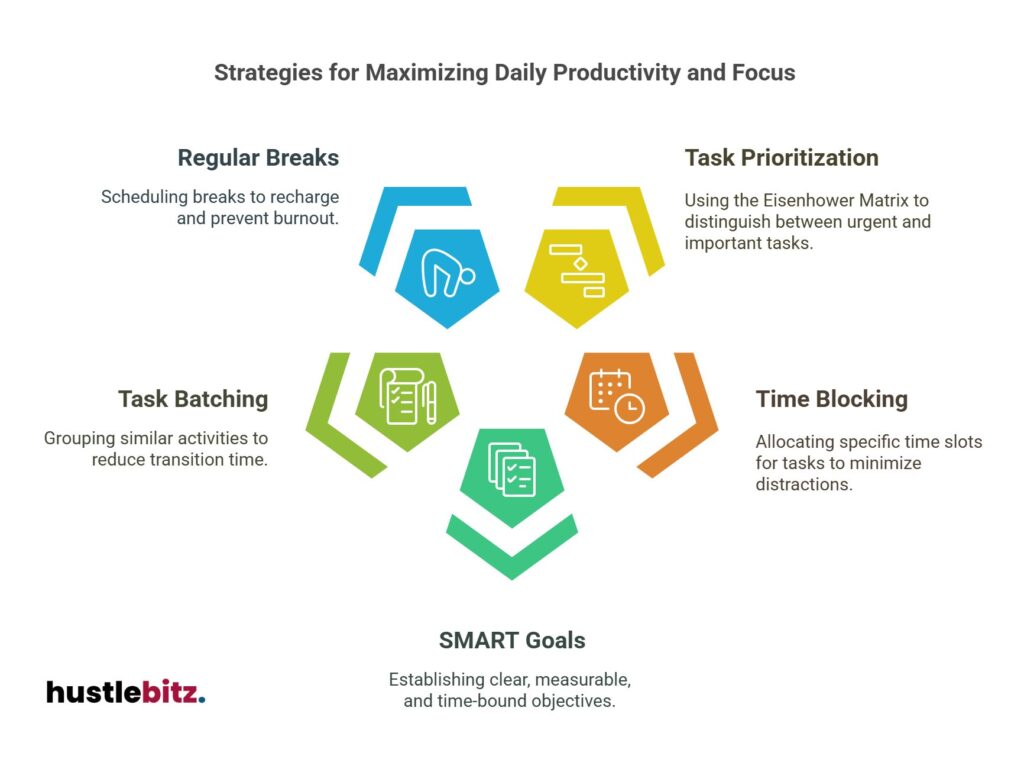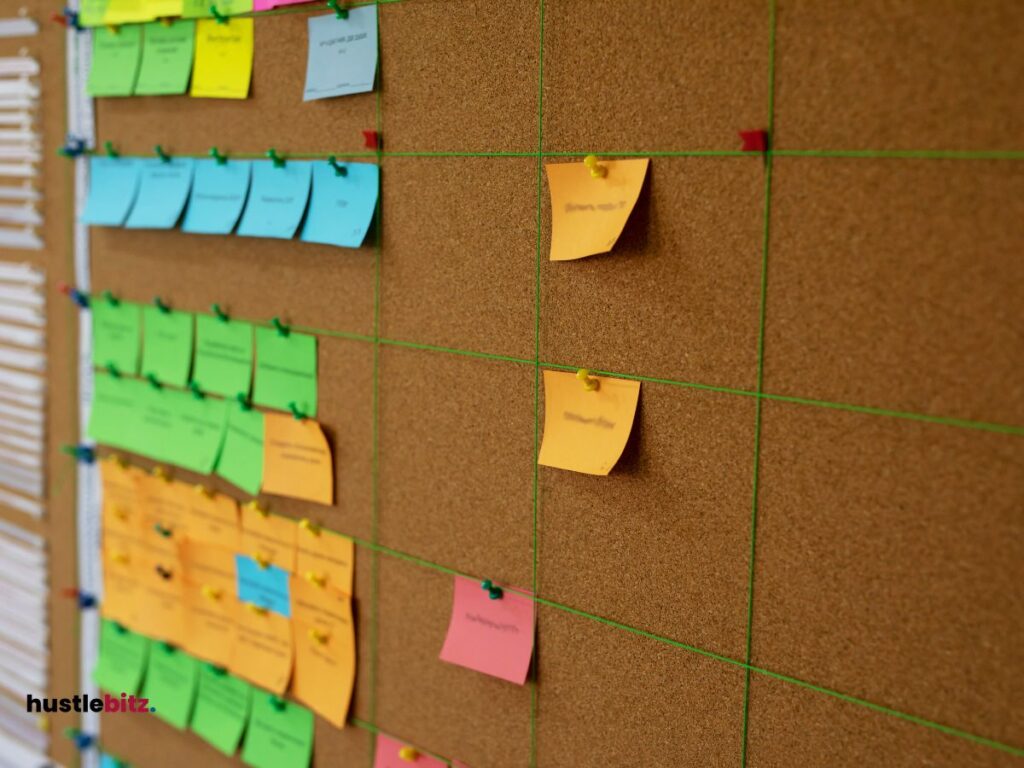To improve daily efficiency, effective time management strategies are essential. Start by prioritizing tasks using the Eisenhower Matrix, which helps distinguish between urgent and important responsibilities. Employ techniques like time blocking to allocate specific periods for focused work, reducing distractions. Batching similar tasks can further streamline your workflow. Setting SMART goals ensures clarity and accountability in your objectives. Additionally, overcoming procrastination through manageable steps and mindful techniques is crucial. Remember to schedule regular breaks to enhance productivity and prevent burnout. Exploring these strategies can provide deeper insights into achieving excellence in time management.
Key Takeaways
- Prioritize tasks using the Eisenhower Matrix to distinguish between urgent and important responsibilities for enhanced focus.
- Implement time blocking to allocate specific time slots for tasks, minimizing distractions and creating structured routines.
- Set SMART goals to establish clear, measurable, and time-bound objectives that align with your priorities.
- Utilize task batching to group similar activities, reducing transition time and boosting overall workflow efficiency.
- Schedule regular breaks to recharge cognitive function, preventing burnout and maintaining sustained productivity throughout the day.

Understanding the Importance of Effective Time Management
Effective time management is crucial for maximizing productivity and achieving personal and professional goals. It serves as a foundation for time awareness, allowing individuals to recognize how they allocate their hours and prioritize tasks effectively. By fostering a clear understanding of how time is spent, individuals can enhance goal clarity, ensuring that their efforts align with their aspirations.
Moreover, effective time management contributes significantly to stress reduction. When tasks are organized and deadlines are clear, the anxiety associated with last-minute rushes diminishes. This organized approach not only streamlines decision-making but also empowers individuals to make informed choices about their time investment. By establishing a proactive rather than reactive mindset, one can navigate challenges with greater ease.
Personal accountability is another vital aspect of time management. By taking ownership of how time is utilized, individuals can set realistic expectations for themselves and hold themselves responsible for achieving their objectives. This fosters a sense of commitment and motivation, leading to enhanced performance.
Furthermore, effective time management promotes work-life balance. It allows individuals to allocate time for both professional responsibilities and personal interests, ensuring a well-rounded lifestyle. Additionally, energy management plays a critical role; understanding when one is most productive enables the strategic scheduling of demanding tasks for optimal performance.
Prioritizing Tasks for Maximum Productivity
Prioritizing tasks is essential for maximizing productivity and ensuring that efforts are focused on the most impactful activities. A clear task hierarchy allows individuals to distinguish between urgent and important tasks, facilitating more informed daily planning. By categorizing tasks effectively, one can allocate time and resources to activities that drive the most significant results.
To enhance productivity, consider the following strategies:
- Utilize focus techniques: Techniques such as the Pomodoro Technique can help maintain concentration and prevent burnout, allowing for sustained productivity throughout the day.
- Implement delegation strategies: Recognizing tasks that can be delegated frees up time for higher-priority responsibilities, enabling a more efficient workflow.
- Practice energy management: Aligning tasks with your natural energy peaks can optimize performance and reduce fatigue.
Moreover, conducting weekly reviews is a vital practice for assessing progress and adjusting priorities. This reflective process allows for the identification of tasks that may have shifted in importance, ensuring that your focus remains aligned with overarching goals.
Utilizing the Eisenhower Matrix to Manage Daily Tasks

The Eisenhower Matrix serves as a powerful tool for managing daily tasks by categorizing them into four distinct quadrants based on urgency and importance, thereby enhancing decision-making and time allocation.
This prioritization matrix facilitates a clear understanding of what must be tackled first, thus improving time management practices and increasing overall productivity.
In the first quadrant, urgent and important tasks require immediate attention. These are the critical deadlines that cannot be postponed.
Moving to the second quadrant, we find important but not urgent activities, which are essential for long-term goals and should be scheduled thoughtfully.
The third quadrant encompasses urgent but less important tasks, often distractions that can be delegated or minimized.
The Power of Time Blocking for Structured Workdays

Implementing time blocking can significantly enhance the structure and efficiency of workdays by allocating specific time slots for tasks, thereby reducing distractions and increasing focus. This planning strategy encourages individuals to designate periods for various activities, ultimately fostering a more organized approach to their daily routines. By concentrating on one task at a time, workers can achieve focused work, leading to noticeable productivity boosts.
The benefits of time blocking extend beyond mere task management, as it also provides schedule flexibility to accommodate unexpected events. Here are three key advantages:
- Structured Routines: Time blocking creates a clear framework for the day, making it easier to adhere to a consistent schedule and establish productive habits.
- Enhanced Focus: By dedicating specific time slots for individual tasks, distractions are minimized, allowing for deeper concentration and improved performance.
- Daily Reflection: Allocating time for reflection at the end of the day enables individuals to assess their accomplishments and adjust future time blocks for optimal effectiveness.
Incorporating time blocking into your daily routine is a powerful method to take control of your time and enhance overall productivity. By consciously planning your day and adhering to structured routines, you can better manage your workload and achieve more in less time.
Embrace this impactful tool to transform your approach to time management and elevate your efficiency in both personal and professional realms.
Task Batching

Building on the principles of time blocking, task batching offers an effective strategy for enhancing productivity by grouping similar activities together and tackling them within designated timeframes. This method not only aids in workflow optimization but also provides an efficiency boost by reducing the time lost in transitioning between diverse tasks. By practicing task grouping, individuals can enhance focus, thereby minimizing distractions that often accompany multitasking.
Task batching is particularly advantageous for deadline management and project coordination, as it allows for a structured approach to completing multiple related tasks within a set period. For instance, dedicating certain hours exclusively to emails, meetings, or content creation can lead to significant improvements in productivity.
The following table illustrates various tasks that can benefit from batching, along with their potential efficiency outcomes:
| Task Type | Benefits of Batching | Timeframe Suggestions |
| Email Management | Distraction reduction, focus enhancement | 30 minutes, twice daily |
| Meetings | Workflow optimization, deadline management | 2 hours, once weekly |
| Content Creation | Efficiency boost, project coordination | 3 hours, twice weekly |
| Administrative Tasks | Focus enhancement, distraction reduction | 1 hour, daily |
| Research | Workflow optimization, efficiency boost | 2 hours, once weekly |
Setting SMART Goals

Setting SMART goals provides a structured framework that enhances clarity and focus, ultimately driving more effective time management practices. The SMART criteria, which stands for Specific, Measurable, Achievable, Relevant, and Time-bound, serves as a guide for goal setting that can significantly improve personal motivation and productivity.
By adhering to these principles, individuals can create measurable objectives that clearly define what success looks like. This approach helps in identifying achievable targets that align with one’s relevant priorities. For instance, rather than stating a vague desire to ‘get fit,’ a SMART goal would articulate, “I will exercise for 30 minutes, five times a week for the next three months.” This specificity allows for tracking progress and maintaining focus.
Key elements of SMART goals include:
- Specific Outcomes: Clearly define what you want to achieve.
- Measurable Objectives: Establish criteria to measure progress and success.
- Time-bound Deadlines: Set a timeline for achieving your goals to foster a sense of urgency.
Incorporating these elements into your goal-setting process not only helps in maintaining a clear direction but also enhances accountability. By setting time-bound deadlines, individuals can prioritize their tasks more effectively, ensuring that they remain aligned with their larger objectives.
Ultimately, SMART goals empower individuals to take actionable steps toward achieving their aspirations, fostering a more organized and efficient approach to time management.
Overcoming Procrastination with Practical Techniques

Procrastination can be effectively tackled through a variety of practical techniques that promote focus and productivity. One effective approach involves implementing motivation techniques, such as visualizing the end goal or breaking tasks into smaller, manageable parts. By fostering a sense of accomplishment with each completed task, individuals can build momentum and reduce the tendency to delay.
Engaging accountability partners is another powerful strategy. Sharing goals and deadlines with a trusted colleague or friend can create a sense of responsibility, prompting individuals to stay on track. This social support can significantly enhance one’s commitment to tasks and deadlines.
Incorporating mindfulness practices can also combat procrastination. By being present and fully engaged in the moment, individuals can recognize distractions and emotional triggers that often lead to avoidance. This heightened awareness can pave the way for better decision-making regarding task management.
Additionally, addressing environmental factors is crucial. Organizing workspaces to minimize distractions and adopting a structured routine can significantly improve focus. Habit formation plays a vital role in overcoming procrastination; establishing consistent work patterns reinforces self-discipline strategies that combat avoidance behavior.
The Role of Regular Breaks in Maintaining Productivity

In the pursuit of enhanced focus and productivity, incorporating regular breaks into a work routine can significantly counteract fatigue and maintain mental sharpness. Research indicates that scheduled breaks are essential for optimizing performance and preventing burnout. By strategically planning break frequency, individuals can effectively manage their energy levels and sustain productivity rhythm throughout the day.
Regular breaks allow for essential cognitive recharge, facilitating focus restoration and enhancing mental clarity. During these intervals, the mind has the opportunity to reset, which can lead to a significant creativity boost upon returning to work. It’s crucial to recognize that not all breaks are equal; their effectiveness is often influenced by duration and activity engaged in during the pause.
Consider the following strategies for maximizing the benefits of regular breaks:
- Short Breaks: Brief pauses of 5-10 minutes every hour can help maintain mental agility.
- Nature Walks: Stepping outside or engaging in light physical activity can refresh your mind and body.
- Mindfulness Exercises: Practicing mindfulness or deep breathing techniques can reduce stress and enhance focus.
Final Thoughts
Effective time management is key to improving daily efficiency and achieving your goals. By implementing strategies like prioritizing tasks, time blocking, task batching, and setting SMART goals, you can create a structured and productive workday. Overcoming procrastination and incorporating regular breaks are also essential for maintaining focus and preventing burnout. Continuously refining these techniques will help you maximize your productivity while maintaining a balanced and fulfilling routine.




